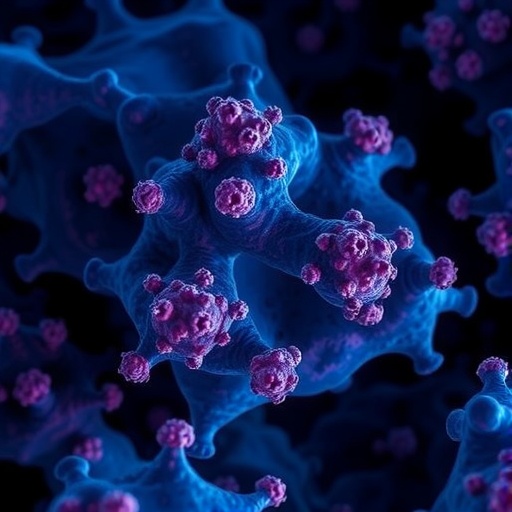Philadelphia, May 8, 2018 A new study in Biological Psychiatry reports that dementia-related and psychiatric-related proteins cluster together to form aggregates in the brain, leading to abnormal cell function and behavior. Aggregation of the protein TDP-43 is a hallmark of a pathological process that leads to dementia called frontotemporal lobar degeneration (FTLD). The study showed that as TDP-43 accumulates in the brain of patients with FTLD, it ropes in DISC1, an important protein in the pathology of many mental conditions.
The findings provide a clue to the unsolved puzzle of why psychiatric disorders often emerge in neurodegenerative disorders. "From the clinical point of view, it is critical to understand the molecular mechanisms underlying psychiatric symptoms in neurodegenerative diseases," said senior author Motomasa Tanaka, PhD, of RIKEN Brain Science Institute, Japan. The findings reveal that the TDP-43/DISC1 protein clusters disrupt the production of new proteins in neurons, a process critical for higher brain functions that are impaired in psychiatric disorders.
First author Ryo Endo, PhD, and colleagues found the co-aggregates in postmortem brain tissue from patients with FTLD and in a mouse model of FTLD. The FTLD model mice were hyperactive and displayed abnormal social interactions, behaviors relevant to multiple psychiatric conditions. Aggregation of the protein renders it unusable, so Dr. Endo and colleagues added DISC1 back into the mice. The behavioral abnormalities in the mice returned to normal.
"At the mechanistic level, TDP-43 and DISC1 co-aggregation disrupted activity-dependent local translation in dendrites," said Dr. Tanaka, a process that builds proteins from DNA codes based on neural activity. The disruption in translation resulted in reduced synaptic protein expression in the mice. Adding DISC1 back in also restored the reduced protein levels. The findings demonstrate that the co-aggregation of DISC1 caused the abnormalities in the model mice, suggesting that the co-aggregation of DISC1 with TDP-43 may disrupt cellular function and trigger psychiatric manifestations.
"DISC1 has long been a focus of research as a consequence of its implication in the heritable risk for schizophrenia," said John Krystal, MD, Editor of Biological Psychiatry. "However, this new study implicates DISC1 in the biology of FTLD. There are still unanswered questions about whether DISC1 is disrupted in association with schizophrenia risk. However, the new study by Dr. Endo and colleagues provides a compelling case for further exploring the role of this protein in frontotemporal dementia," he added.
###
Notes for editors
The article is "TDP-43 and DISC1 Co-Aggregation Disrupts Dendritic Local Translation and Mental Function in FTLD," by Ryo Endo, Noriko Takashima, Yoko Nekooki-Machida, Yusuke Komi, Kelvin Kai-Wan Hui, Masaki Takao, Hiroyasu Akatsu, Shigeo Murayama, Akira Sawa, and Motomasa Tanaka (https://doi.org/10.1016/j.biopsych.2018.03.008. It appears in Biological Psychiatry, published by Elsevier.)
Copies of this paper are available to credentialed journalists upon request; please contact Rhiannon Bugno at [email protected] or +1 214 648 0880. Journalists wishing to interview the authors may contact Motomasa Tanaka at [email protected].
The authors' affiliations and disclosures of financial and conflicts of interests are available in the article.
John H. Krystal, MD, is Chairman of the Department of Psychiatry at the Yale University School of Medicine, Chief of Psychiatry at Yale-New Haven Hospital, and a research psychiatrist at the VA Connecticut Healthcare System. His disclosures of financial and conflicts of interests are available here.
About Biological Psychiatry
Biological Psychiatry is the official journal of the Society of Biological Psychiatry, whose purpose is to promote excellence in scientific research and education in fields that investigate the nature, causes, mechanisms and treatments of disorders of thought, emotion, or behavior. In accord with this mission, this peer-reviewed, rapid-publication, international journal publishes both basic and clinical contributions from all disciplines and research areas relevant to the pathophysiology and treatment of major psychiatric disorders.
The journal publishes novel results of original research which represent an important new lead or significant impact on the field, particularly those addressing genetic and environmental risk factors, neural circuitry and neurochemistry, and important new therapeutic approaches. Reviews and commentaries that focus on topics of current research and interest are also encouraged.
Biological Psychiatry is one of the most selective and highly cited journals in the field of psychiatric neuroscience. It is ranked 6th out of 142 Psychiatry titles and 10th out of 258 Neurosciences titles in the Journal Citations Reports® published by Thomson Reuters. The 2016 Impact Factor score for Biological Psychiatry is 11.412. http://www.sobp.org/journal
About Elsevier
Elsevier is a global information analytics business that helps institutions and professionals advance healthcare, open science and improve performance for the benefit of humanity. Elsevier provides digital solutions and tools in the areas of strategic research management, R&D performance, clinical decision support and professional education, including ScienceDirect, Scopus, SciVal, ClinicalKey and Sherpath. Elsevier publishes over 2,500 digitized journals, including The Lancet and Cell, more than 38,000 e-book titles and many iconic reference works, including Gray's Anatomy. Elsevier is part of RELX Group, a global provider of information and analytics for professionals and business customers across industries. http://www.elsevier.com
Media contact
Rhiannon Bugno
Editorial Office, Biological Psychiatry
+1 214 648 0880
[email protected]
Media Contact
Rhiannon Bugno
[email protected]
214-648-0880
@elseviernews
http://www.elsevier.com
https://www.elsevier.com/about/press-releases/research-and-journals/a-new-mechanism-for-neurodegeneration-in-a-form-of-dementia
Related Journal Article
http://dx.doi.org/10.1016/j.biopsych.2018.03.008




